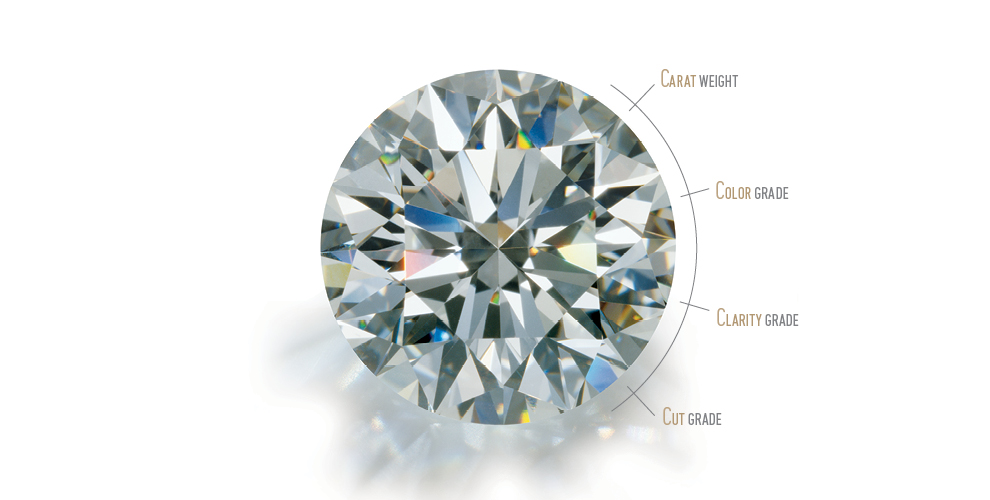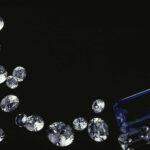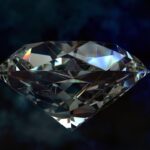Diamond 4C
- Home
- Diamond 4C
There are Four Types of Diamond 4C:-
- Cut
- Color
- Clarity
- Carat weight

(1) Diamond CUT
The Ideal cut diamond is designed to maximize brilliance, and with the typically smaller table size these diamonds have the added benefit of creating a great deal of dispersion or ‘fire’ as well. Ideal quality diamonds are truly for the person who enjoys knowing that they have one of the finest quality diamonds that money can buy. The Ideal cut category applies only to round brilliant cut diamonds.
Excellent:This cut is intended to maximize brilliance. Excellent cut diamonds generally have smaller tables, complemented by a great deal of light dispersion, or fire. GIA’s Excellent stones, as well as AGS 000 stones fall into this category. This category applies only to round diamonds and most valued.
The best cut grade that a diamond can receive is excellent. This means that the diamond has achieved maximum brilliance, and it reflects virtually all of the light that enters the gem. A diamond with an excellent cut grade will have an even pattern of light and dark areas, and specially-designed optical measuring devices can carefully determine the measurements of the facets. The facets will be symmetrical and beautifully polished for the best possible shine and reflection. If you’re searching for the perfect cut, then look for a diamond with an excellent cut grade. Very GoodThese diamonds reflect most of the light that enters, creating a good deal of brilliance. With these diamonds, the cutters have chosen to stray slightly from the preferred diamond proportions in order to create a larger diamond.
The next level of classification for a diamond cut grade is very good. Looking at a diamond from the top down, you might notice that a very good diamond has more darkness than is desirable. Some of the facets may be cut in a way that is not perfectly proportional, or some of the facets may not have been shined and polished in the right way. To the naked eye, this may still be a beautiful and reflective diamond without any obvious flaws.
Diamonds that reflect the light that enters them come under the good category. Such stones result from the cutter’s choice to create the largest possible diamond from the original rough crystal, rather than cutting extra weight off to create a smaller Premium quality diamond. Diamonds in this range offer an excellent cost-saving to customers who want to stay in a budget without sacrificing quality or beauty.
The middle of the five categories for diamond cut grade is good. A diamond with a good cut rating is far from perfect, but it may be a good choice for those in search of value. These Diamonds are not cut to maximize their reflection of light. The girdle thickness may be less than ideal, which can impact how durable the diamond is.
FairA diamond graded as fair or poor reflects only a small proportion of the light that enters it. Often these stones are bought and re-cut into Ideal or Premium cuts, such that a more brilliant stone is produced by sacrificing some weigh.
The second-to-last classification for diamond cut is a grade of fair. A fair cut grade means that there is a lot of light escaping from the diamond, making its appearance less brilliant and sparkling than it could be. In larger Diamonds, a fair rating is less common. In smaller Diamonds of less than one carat, a fair cut may be less noticeable and less problematic for buyers.
PoorThe lowest cut grade for a diamond is the poor. When a diamond falls into this category, it means that the cut is subpar in multiple ways. Even to the untrained eye, a poorly cut diamond will look dull instead of bright and reflective. The diameter of the diamond could be off, or the facets may be the wrong size. Either way, the diamond isn’t living up to its full potential.
(2) Diamond COLOR
The GIA (Gemological Institute of America) colour grading classification starts from D, the finest colour grade (colourless), and continues through the alphabet to Z becoming progressively more tinted to yellow. A set of master comparison stones calibrated to the exact colour of every colour grade is the most reliable method of grading diamonds for colour. This allows for the accurate colour grading of the diamond.
Diamonds come in a variety of colors, some of them highly prized (pinks, blues, even yellow). However in a white diamond, the presence of a yellow tint will lower the price of a diamond. The less body color in a white diamond, the more true color it will reflect, and thus the greater its value.
Every Diamond has been assigned a color grade by the GIA ( Gemological Institute of America) in a viewing environment specially designed to eliminate color from surrounding surfaces as well as the light source itself. This allows the color of the diamond to be accurately measured. Minor differences in diamond color detected in this environment are very difficult if not impossible to detect in a normal environment. The diamond industry has adopted the GIA (Gemological Institute of America) diamond color scale; almost every diamond sold today is rated using the GIA color scale, whether it was actually certified by the GIA (Gemological Institute of America) or not.
The GIA (Gemological Institute of America) grades diamonds on a scale of D (colorless) through Z (light color). All D-Z diamonds are considered white, even though they contain varying degrees of color. True fancy colored diamonds (such as yellows, pinks, and blues) are graded on a separate color scale.
Below is the GIA (Gemological Institute of America) diamond color chart with definitions, accompanied by further explanatory comments from Diamond Bourse.
(3) Diamond CLARITY
Clarity is a term used to describe the absence or presence of flaws inside or on the surface of a diamond. In other words, the clarity of a diamond refers to a diamond’s clearness or purity.
When these flaws / marks occur internally, they are called inclusions. The most common types of inclusions include crystals, (tiny bubbles representing small minerals that were absorbed into the diamond while it was growing), internal graining, needles, knots, chips, cavities, cleavage, feathers, and clouds. On the contrary, when these flaws / marks occur on the surface, they are known as blemishes. The most common types of blemishes include polish lines, naturals, scratches, nicks, pits, transparent stress lines that appear on a diamond’s surface, surface graining, and extra facets. Blemishes are usually cut to remove a near-surface inclusion to raise the clarity grade of a stone. Most diamonds have these imperfections in them. Although many of these flaws are not visible to the naked eye, but under magnification, tiny featherlike shapes, crystals, bubbles and dark flecks become noticeable. These slight flaws make every diamond quite unique but they also affect the beauty and value of the diamond.
A diamond’s clarity is based on the number, size, nature, and location of imperfections on the finished stone. A diamond with higher clarity is more valuable in comparison to a diamond that contains numerous inclusions because it is less brilliant, as the inclusions interfere with light passing through it.
(4) Carat WEIGHT
Carat is the measure of how much a diamond weighs. Diamond carats is often denoted as “carats” or “ct.”.
What is a Carat ?
A carat is a type of weight measure. Diamonds, just like other kinds of gemstones, are weighed using the metric carats.
- A carat equals two-tenths of a gram or 200 milligrams, (1 carat = 0.2 grams = 200 milligrams).
- Each carat is then divided up into 100 total points. (1 carat = 100 points)
- Therefore, a 50-point gemstone can be expected to weigh 0.50 carats or 1/2 of a carat.
The origin of carat weight and its acceptance as an industry standard
The origins of using the carat as a measurement of weight come from the early days of trading when carob seeds were used as counterweights to balance scales for gem traders. These seeds were generally a uniform weight, so their use was something everyone could agree on as a way of measuring weight. Over time, this evolved into the carat weights used today.
The price per carat varies based on the Diamonds characteristics. The base price per carat is determined using a combination of carat weight, clarity, and color. Other characteristics of the diamond such as cut, fluorescence, polish, etc. can add a premium or discount the base per carat price. The per carat price is dynamic and changes weekly varying based on the demand and supply of Diamonds available globally.
Carat Weight vs Price Per Carat






